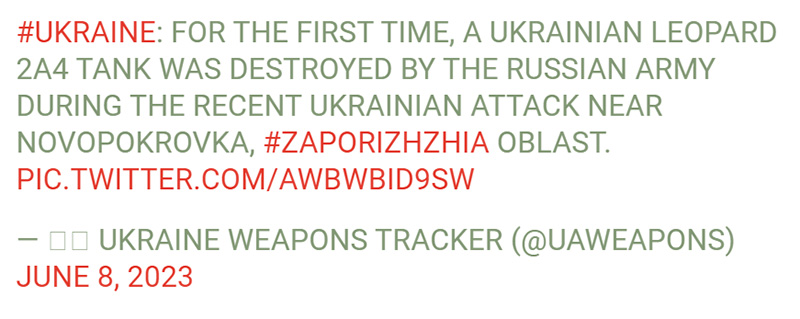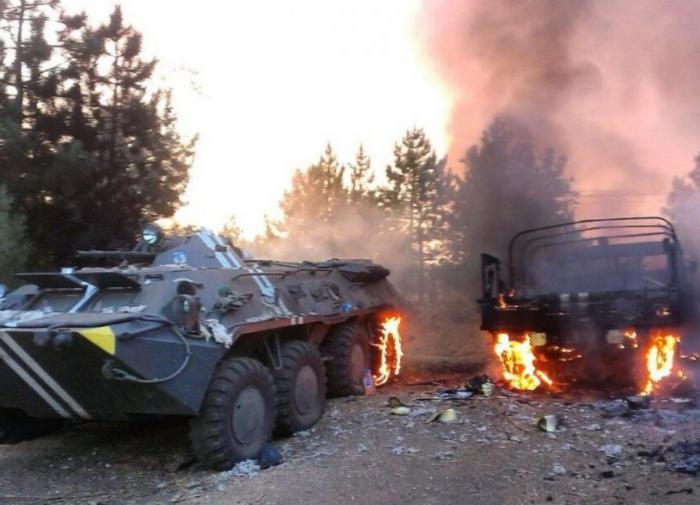
The Ukrainian army’s 33rd Mechanized Brigade and 47th Assault Brigade massed their Leopard tanks and Bradley fighting vehicles for a powerful assault on Russian positions two miles south of Mala Tokmachka in southern Ukraine’s Zaporizhzhia Oblast on or before Thursday morning, writes Forbs.
A dense minefield lay between the Ukrainians and their objective. And the Ukrainians knew it. They deployed at least one IMR-2 engineering vehicle and a Leopard 2R breaching vehicle in the hope of plowing away the mines and clearing a path for at least a company of 47th Brigade M-2A2 Bradleys and some attached Leopard 2A6s from the 33rd Brigade.
The engineers failed — either because the minefield was too dense or Russian helicopters or artillery interrupted their efforts to clear the mines. In short order, the IMR-2, a rare Leopard 2A6 and as many as nine Bradleys piled up, out in the open. Exposed, under fire and taking damage, the surviving crews and passengers bailed out — and took their dead and wounded with them.
The assault — a so-called “breach” targeting prepared enemy fortifications — failed. The 33rd Brigade-47th Brigade battlegroup lost much as five percent of each vehicle consignment in a single morning.
Some of the assault force retreated with its vehicles intact. The crew of one Leopard 2R breaching vehicle abandoned its heavy, British-made mineplow before high-tailing it off the battlefield.
Russian fortifications south of Mala Tokmachka—manned by the Russian 291st and 70th Motor Rifle Regiments, the 22nd and 45th Spetsnaz Brigades and a reserve unit—are more imposing than Ukrainian intelligence indicated, clearly.
The 33rd and 47th Brigades’ debacle near Mala Tokmachka might be Kyiv’s first major defeat of the counteroffensive, but it won’t be the last.
In what can be deemed a remarkable accomplishment for Russia, its forces successfully destroyed at least one Leopard 2 tank on June 7 during a recent Ukrainian assault near Novopokrovka, Zaporizhzhia Oblast.
A video released by the Russian Ministry of Defense on June 8 depicted a Russian artillery strike targeting a Ukrainian vehicle column in southern Ukraine.
In the released footage, a convoy of Leopard 2 and other Ukrainian armored vehicles, traversing an unpaved road outside occupied Novopokrovka or the neighboring Mala Tokmachka, can be seen falling victim to a devastating Russian artillery strike.

According to Forbes, Ukraine’s allies have committed to providing 85 Leopard 2 tanks, consisting of short-gun A4, newer short-gun A5, and long-gun A6 models.
David Axe, a Defense expert, said that if the Russians manage to destroy all the pledged Leopard 2 tanks currently provided by Ukraine’s allies for the war effort, Ukraine can still expect additional tanks to reinforce its forces.
This includes the delivery of 31 M-1 Abrams tanks from the United States and over 130 Leopard 1 tank from a consortium involving Denmark, the Netherlands, and Germany. These incoming tanks will help maintain Ukraine’s military strength despite potential losses.

This week, Ukraine launched its long-planned offensive against Russian-occupied territory, throwing armored columns, including NATO-supplied main battle tanks, against entrenched Russian positions. According to information provided by Russian officials, which has not been contradicted by the Ukrainian government, the initial offensive has resulted in a series of military debacles for the Ukrainian armed forces, writes Andre Damon, a Global Research observer.
The Russian Ministry of Defense released footage of columns of Ukrainian armor, apparently advancing without air cover in open fields, with disastrous results. The footage also depicted the destruction of a German Leopard 2 battle tank, according to the Russian government. The New York Times wrote that US officials “confirmed that advancing Ukrainian troops had suffered casualties in the early fighting,” effectively conceding the truth of the Russian claims.
Given the belief of the US-NATO powers that the offensive would produce a staggering defeat for the Russian government, one purpose was to set the stage for the upcoming July 11-12 NATO summit in Vilnius, Lithuania.
The meeting in Vilnius was conceived of as a summit of victors, in which the battlefield successes of Ukraine would serve as the basis for a whole series of ultimatums to Russia, including a full withdrawal not only from portions of Ukraine seized during the 2022 invasion, but also from the Crimean peninsula.
Should the Vilnius summit take place under conditions of major setbacks and even a breakdown of the offensive, as at this points appears more likely, it will become the occasion for a massive further escalation of US-NATO involvement in the war.
What was conceived of as a summit of victors may prove to be a summit of desperate governments prepared to take the most reckless actions to reverse the outcome of the war.
In the event of a military debacle for Ukraine, there exists the extreme danger that the NATO powers will respond with the declaration that they will implement a no-fly zone over Ukraine, involving NATO warplanes attacking Russian aircraft, and the deployment of ground troops from NATO member states into Ukraine.
For NATO, no less than for Russia, the war is taking on an existential character. It is absolutely central to the Biden administration’s global strategy, in which the military defeat of Russia is necessary to set the stage to take on China.
As the war has progressed, the NATO member states have repeatedly crossed all of the “red lines” they had set for themselves. A recent article in the Economist — whose latest issue is entirely devoted to Ukraine’s current offensive — explains the considerations animating the ever-greater US/NATO involvement in the war. The Economist writes:
“America’s generals increasingly think it is possible to engineer a “strategic defeat” for Russia. Over time they have become less fearful of nuclear escalation… This goal is especially enticing to America’s military planners because they have long dreaded the prospect of having to fight two wars at once: with Russia in Europe and with China in Asia. If the threat from Russia were to be substantially reduced, at least for some years, it would allow more resources to be directed towards deterring China, which has become America’s most pressing military concern.”
To date, the Russian government has not responded to the increasingly reckless provocations being carried out by NATO because it seeks to come to some sort of peaceful resolution of the conflict.
But every one of the “red lines” crossed by NATO serves to further intensify pressure from within the Russian military on the Putin government to carry out its own escalation.
The NATO powers are engaging in a series of actions that threaten not only a massive conventional escalation, but a nuclear war. Whether they succeed or lose on the battlefield, they are committed to a course of action with disastrous consequences for all of humanity, Andre Damon stresses.
read more in our Telegram-channel https://t.me/The_International_Affairs

 17:38 10.06.2023 •
17:38 10.06.2023 •






















